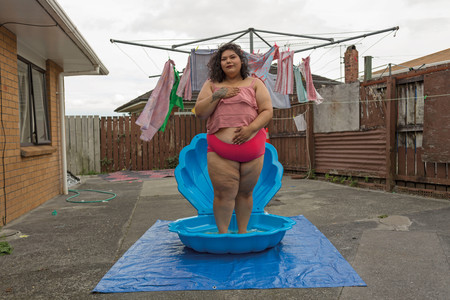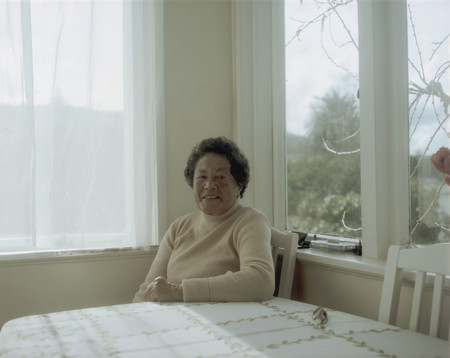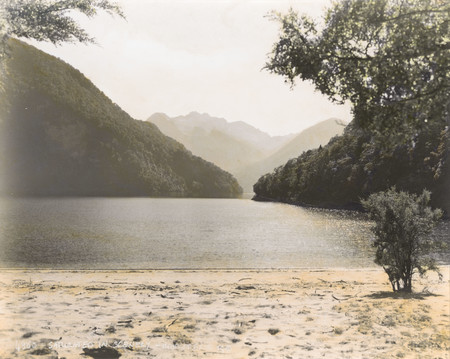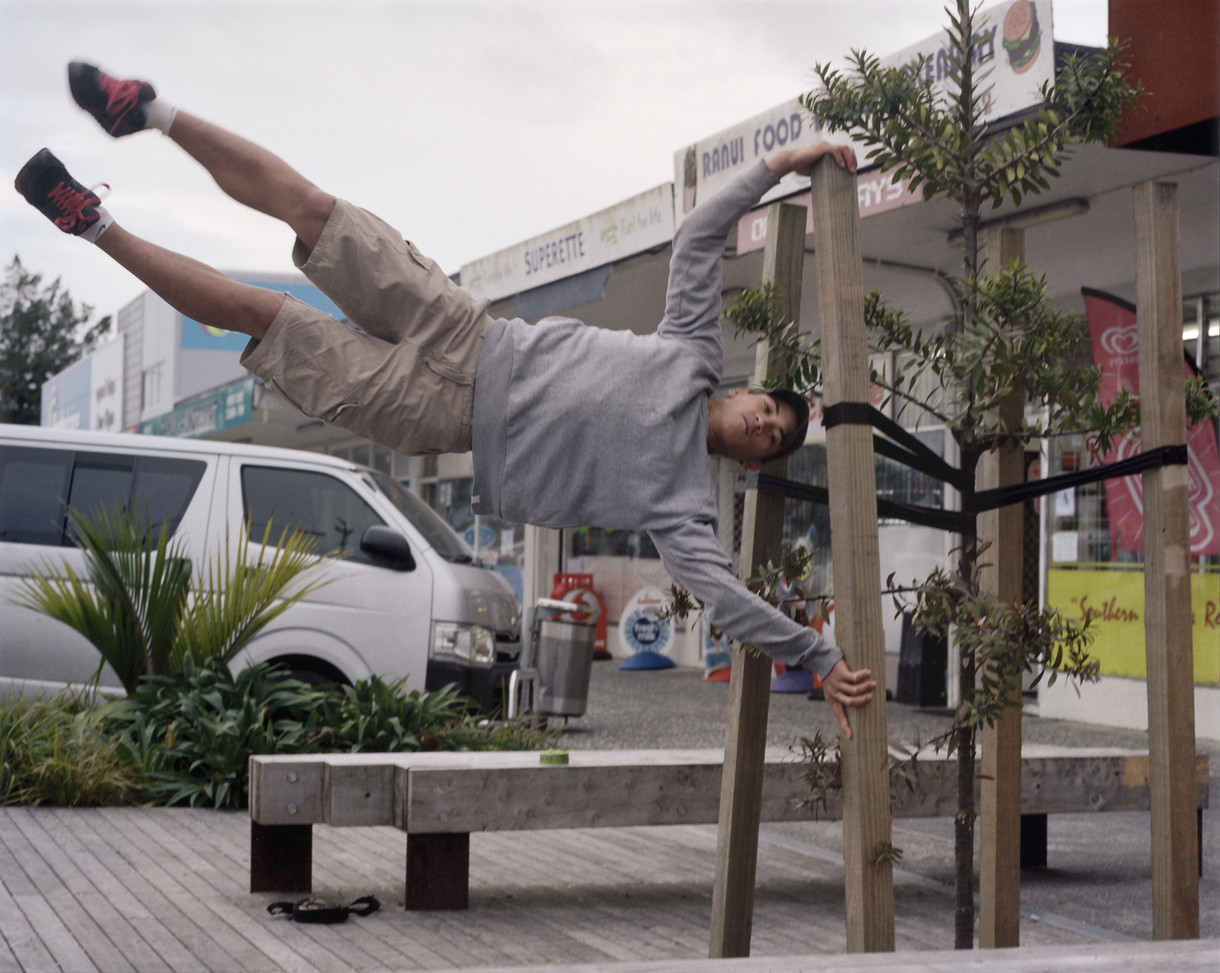New Photographs in the Collection

Edith Amituanai Hendo 2011. Digital photograph, mounted on diabond. Collection of Christchurch Art Gallery Te Puna o Waiwhetū, purchased 2022
Our new collection exhibition Perilous: Unheard Stories from the Collection features a number of newly acquired works from Aotearoa New Zealand artists that expand our contemporary photographic collection. Melanie Oliver asked a few of these artists to share their thoughts on photography and the works that have found a new home at Christchurch Art Gallery Te Puna o Waiwhetū.
Louisa Afoa
Aotearoa/Samoa

Louisa Afoa Blue Clam 2018. Digital photograph. Collection of Christchurch Art Gallery Te Puna o Waiwhetū, purchased 2021
Both the history of art and the camera as a tool are important for your work. Are you able to share a bit about your relationship with the technology of photography and why you favour this medium?
When I was in art school I took a photograph of my younger cousin with a medium-format Hasselblad – I remember being so happy with that photograph. However when it was critiqued by my peers I was told that it looked like a mugshot. It was then that I truly discovered the power and politics of representation. And so photography became my chosen medium as I investigated how I could make images with a compassionate lens, without anyone calling my family images mugshots ever again.
There are some consistent narratives or areas of interest in your practice, in particular a focus on reflecting your community. When starting a new body of work, what inspires you or how do you approach this?
I work in a responsive way, so usually my work is inspired by my friends and family around me and how they navigate the daily grind.
In relation to the photograph that we have recently acquired for the collection, Blue Clam, is there anything that you’d like audiences to know when they see the work?
Blue Clam is from an ongoing series of work titled A Pool is not the Ocean. This series was begun as a response to my experiences in moving from my family home in Papakura to Torbay on Auckland’s North Shore, and the prejudice I experienced there. Now it continues as a vehicle to explore notions of the indigenous body as a political site. Moving from behind the lens to being in front of it was incredibly difficult for me as I struggled with the possibility of being a negative stereotype for my people – another bad health statistic that could be weaponised against myself and my family.
However, going back to the writing of Epeli Hau‘ofa and the ideas of vastness and sovereignty in his text, ‘Our Sea of Islands’, the need to assert my autonomy in the world became more important to me than the potential for criticism.
Oceania is vast, Oceania is expanding, Oceania is hospitable and generous, Oceania is humanity rising from the depths of brine and regions of fire deeper still, Oceania is us. We are the sea, we are the ocean, we must wake up to this ancient truth and together use it to overturn all hegemonic views that aim ultimately to confine us again, physically and psychologically, in the tiny spaces which we have resisted accepting as our sole appointed place, and from which we have recently liberated ourselves. We must not allow anyone to belittle us again, and take away our freedom.1
Ngahuia Harrison
Ngātiwai, Ngāpuhi

Ngahuia Harrison Aunty Reo 2018. Large-format photograph. Collection of Christchurch Art Gallery Te Puna o Waiwhetū, purchased 2022
Both the history of photography and the camera as a tool are important for your work. Are you able to share a bit about your relationship with the technology of photography and why you favour this medium?
My interest in large-format photography started when I took a course at art school taught by Haru Sameshima and Darren Glass. I remember Haru explaining that when using a large-format camera he might only have taken one or two photos after a day of shooting. I liked that the technology made you slow down, not only in the shooting, but also because as an analogue process you have to wait to develop the film. The development process itself takes time, and then you wait for the negatives to dry before you can scan or expose them. The whole process is slow and has particular steps you have to follow and I was drawn to this. Artmaking can contain a lot of insecurity or not-knowing, so I like that working in photography has a routine and a rhythm to it.
There are some consistent narratives or areas of interest in your practice, in particular a focus on your whānau and relationships to water. When starting a new body of work, what inspires you or how do you approach this?
My grandparents both whakapapa to coastal iwi in Northland. My Nan grew up on the Waikere Inlet, by Russell. My Grandad lived on Aotea (Great Barrier Island) and at the coastal settlement Whananaki, both kāinga of our hapū Ngāti Rehua. Whananaki is where they settled and brought their kids up near our marae. They both whakapapa to the coastal iwi Ngātiwai; the importance of water to the tribe is carried in our name. We have many pepeha, songs, proverbs that highlight the importance of water to who we are, such as ‘Ko nga mana katoa o Ngātiwai kei te wai, i ngā taniwha me o ratou manawa’ (‘All the power of Ngātiwai comes from the sea, from its guardian taniwha and their spiritual force’). So this is where I start from when thinking about bodies of water and our relationship to them. The centuries we have occupied our environment affect the way we see ourselves today and how we relate to our coast, which we call Te Akau Roa o Ngātiwai. Another whakataukī that exemplifies this was spoken by our tūpuna Manaia who said “Ahakoa e tū ana ki te whenua, e noho ana au ki te moana” – “though you stand on land, you also sit on the sea”. This proverb speaks to the fact that when you are in Ngātiwai territory you are never far from the sea, but also to the longing Manaia’s descendants would feel when they are away from their ocean.
In relation to the photographs that we have recently acquired for the collection, Aunty Reo and Te Wairahi, is there anything that you’d like audiences to know when they see the work?
Aunty Reo was made for an exhibition at the Adam Art Gallery, which included Ana Iti, Raukura Turei and Nova Paul. The exhibition coincided with Suffrage 125. It was the first time I had considered my work within a lens of intersectional feminism in any focused way. So it was an opportunity to make work in response to this. At the same time I had been working with one of our Aunties to pull together photos of our tūpuna that people might have had in their homes, so we could make copies and put them in our new wharenui. I realised as we were travelling around doing this that all the people that had these photo collections and were caring for them were all our kuia. So it started by wanting to photograph and document these kaitiaki at the same time they showed us through their photo collections. Of course the photos we were copying from their archives were of our dead, and the photos I was taking are of the living. So there are these two threads of living and dead in the project, two realms which at the same time as being very separate worlds, also co-exist. The work Te Wairahi, which depicts our awa in Whananaki is also echoing this idea of two worlds that co-exist.
Bridget Reweti
Ngāti Ranginui, Ngāi Te Rangi

Bridget Reweti 4860 SATURATED IN SCENERY 2021. Whenua coloured silver gelatin print. Collection of Christchurch Art Gallery Te Puna o Waiwhetū, purchased 2022
Both the history of photography and the camera as a tool are important for your work. Are you able to share a bit about your relationship with the technology of photography and why you favour this medium?
I’ve always loved the process of harnessing light to create an image. Like many things in life, it’s a science that is wondrous with many different applications. Currently I’m interested in the camera technology that was used during the early 1900s in Aotearoa. The images made during this time are indicative of massive loss, often made under exploitative circumstances, but within the complexity of life they are now really treasured. I often like to think what images we would have from these times if someone like myself was behind the lens.
There are some consistent narratives or areas of interest in your practice, in particular a focus on land. When starting a new body of work, what inspires you or how do you approach this?
Projects are often ticking away in my mind and when I do get the opportunity to work on them, there’s usually already a substantial amount of research. I’m often inspired to begin a body of work after talking with people but know it’s really important to not tell narratives that are not mine to tell. I find this intersection of living away from my own rohe and working with land a good challenge. Forming a connection back to who and where I’m from is paramount and also exciting because it helps to reveal layers of histories and travel.
In relation to the photographs that we have recently acquired for the collection, from the Summering on Lakes Te Anau and Manapouri series, is there anything that you’d like audiences to know when they see the work?
I had so much fun making these photographs, spending the summer of 2020/21 staying at a friend’s home in Te Anau and traveling with family and friends to different locations with my large-format camera. These photographs are hand-coloured using pigment collected from around the shores of the lakes. I want audiences to almost be able to feel the warmth of light that is contained within the photos and the range of colours within the lands we call home.
Edith Amituanai
Aotearoa/Samoa

Edith Amituanai Hendo 2011. Digital photograph, mounted on diabond. Collection of Christchurch Art Gallery Te Puna o Waiwhetū, purchased 2022
Both the history of photography and the camera as a tool are important for your work. Are you able to share a bit about your relationship with the technology of photography and why you favour this medium?
I have described on a few occasions my finding of the medium that best suited me through a process of art school elimination; I think the camera separates you, and I really need that distance to see what I’m trying to do. I heard a saying about photography, ‘slow, slow, quick’ – the making of a photograph can be very quick after the shutter is pushed but, for me especially, the before is very slow. Regarding the history, finding out what was made before your time and what’s current now is crucial, I mean how can you not? I often say to my students, it’s like saying you love music but you never listen to musicians and you can’t name a song that is part of your life’s soundtrack.
There are some consistent narratives or areas of interest in your practice, in particular a focus on communities and giving agency to your subjects. When starting a new body of work, what inspires you or how do you approach this?
I think I am consistently drawn to the unseen, overlooked and misunderstood, whether that is done in public or private, from living rooms to parks. In particular, things that we might think we know, have read about but lack a kind of clear visual language in our minds. That might mean making photographs of young people hanging out in public spaces, in front of train stations and shops on the suburban streets of Auckland. Or it could mean photographing living rooms with a kind of Pacific migrant aesthetic or loud siren speakers stacked on top of cars. My aim is not really about agency – that might imply that I do not benefit from the relationship which is not true – but I do think about the duty of care once I decide to focus on something. Mostly I think it starts with asking, what do I want to focus on and how can I take care of that and at the same time push past what’s easy?
In relation to the photographs that we have recently acquired for the collection, a couple of works from your The End of my Driveway series, is there anything that you’d like audiences to know when they see the work?
In this series, the camera vantage point moves around on the driveway. I remember standing on the driveway and physically I could not stay in one place – I was only allowing myself to photograph one frame per person but I just couldn’t wait for the action to come to me and I had to move to it. The process of making work is so funny, these rules you make up for yourself and the things you do and won’t do.









